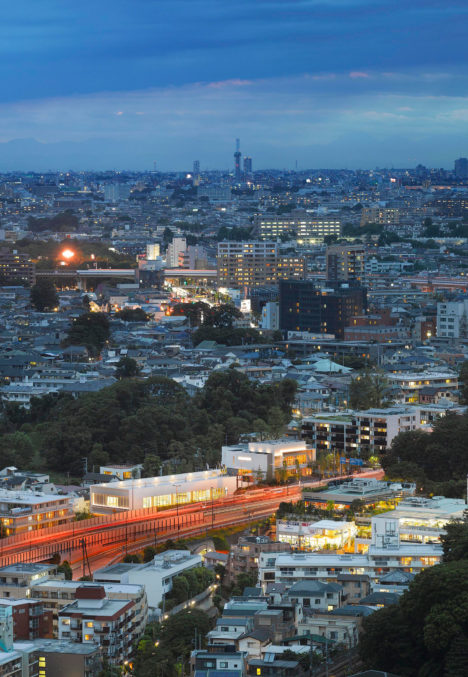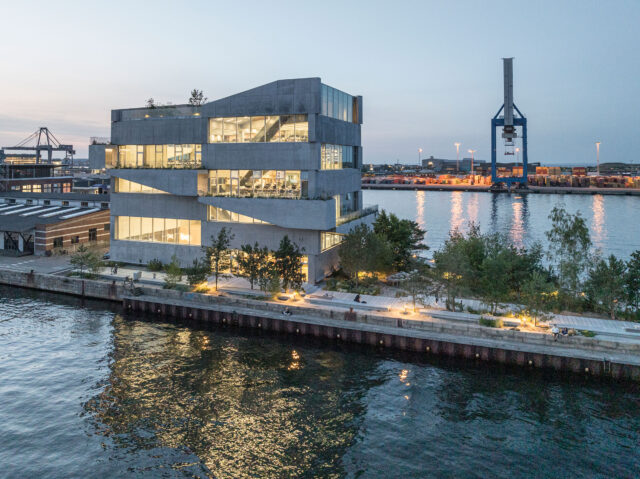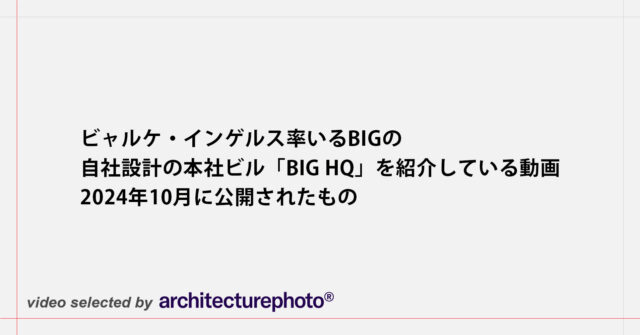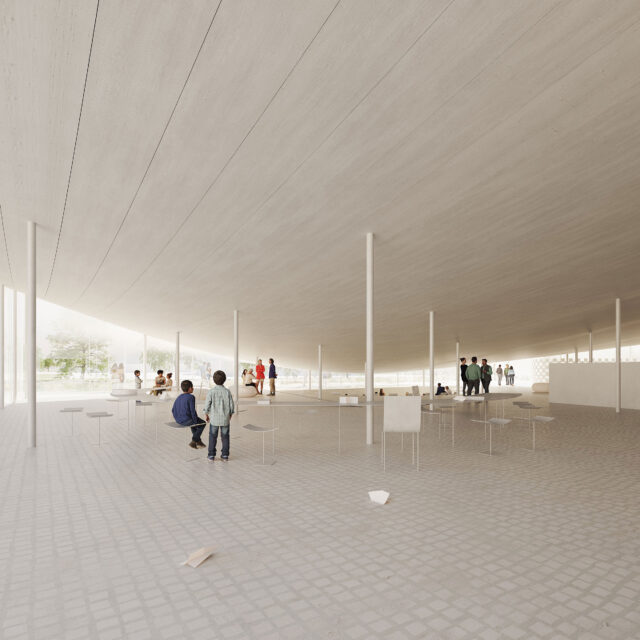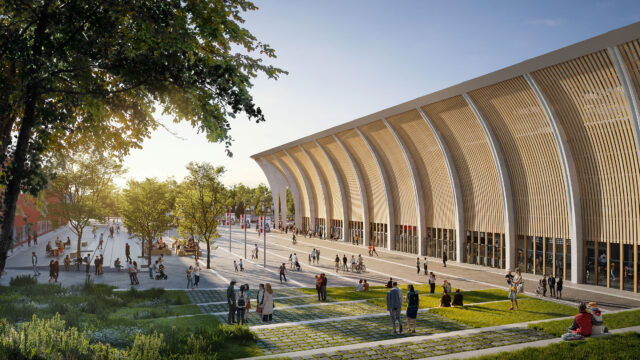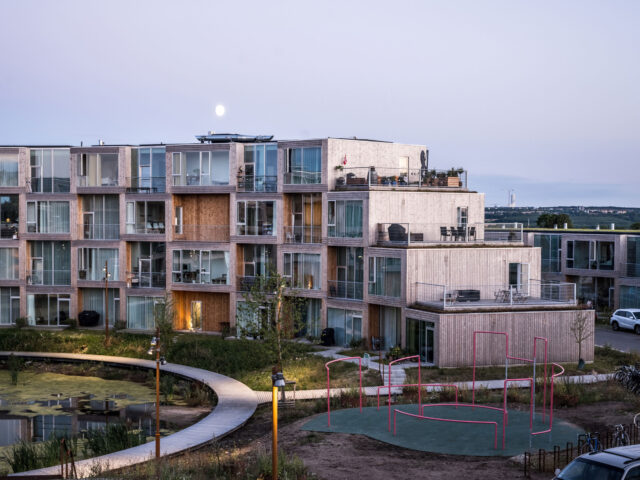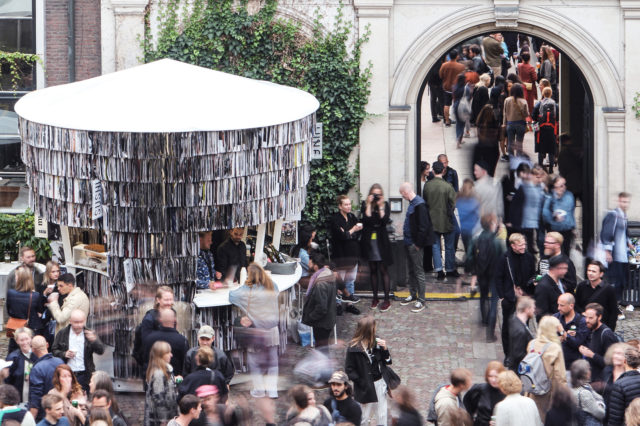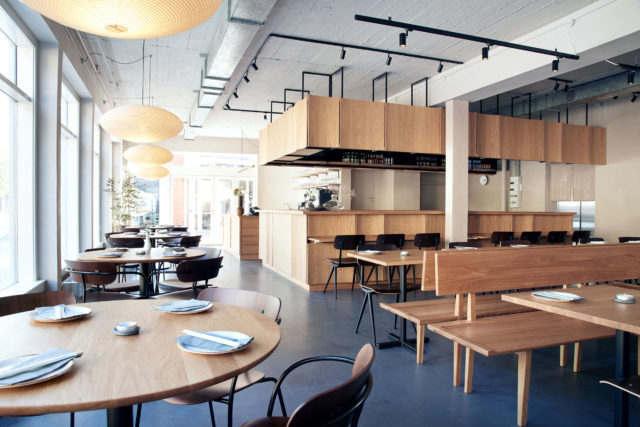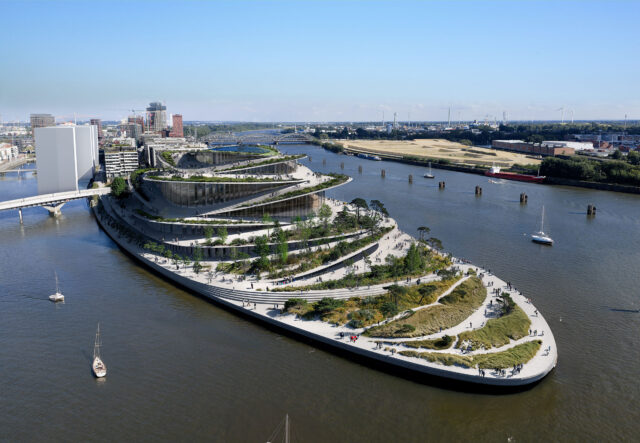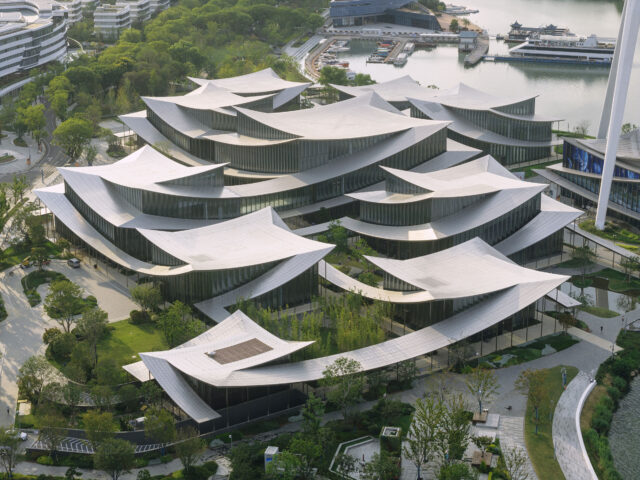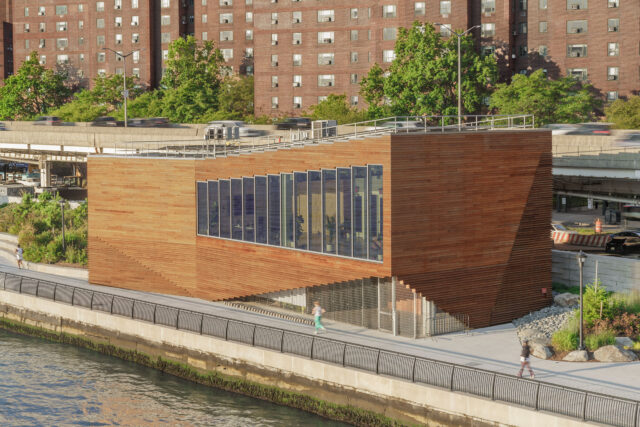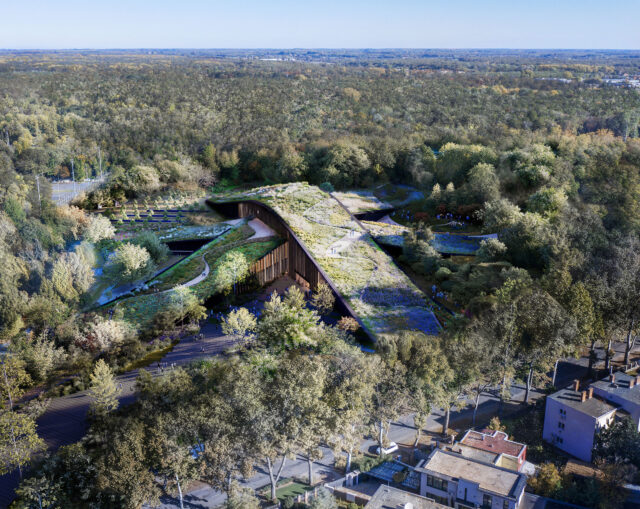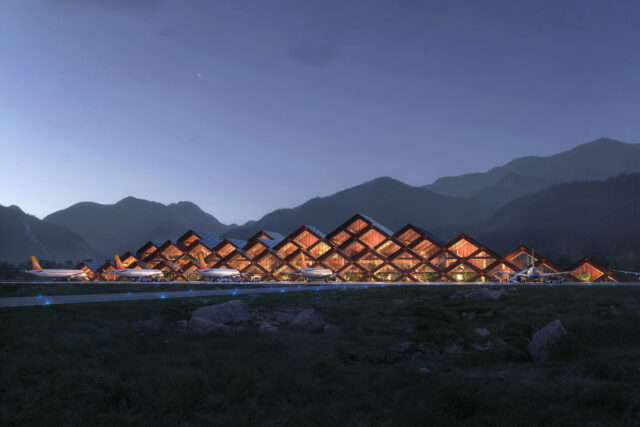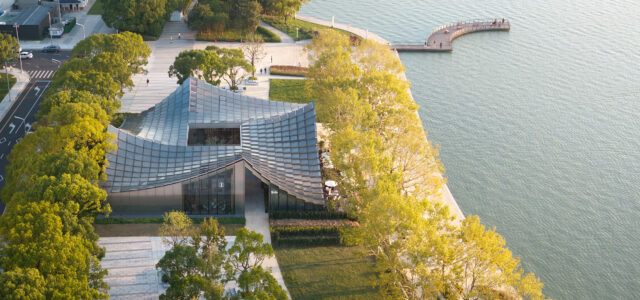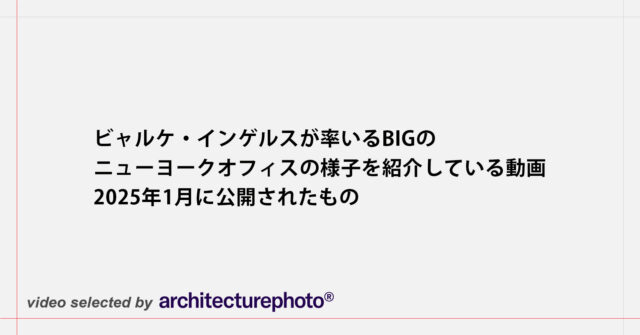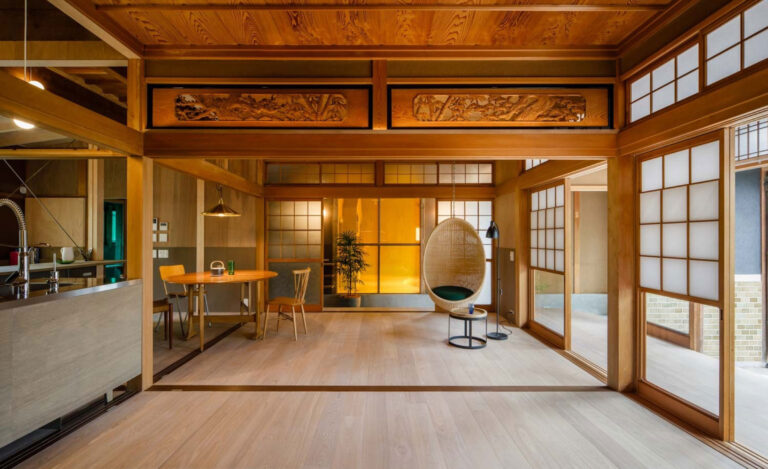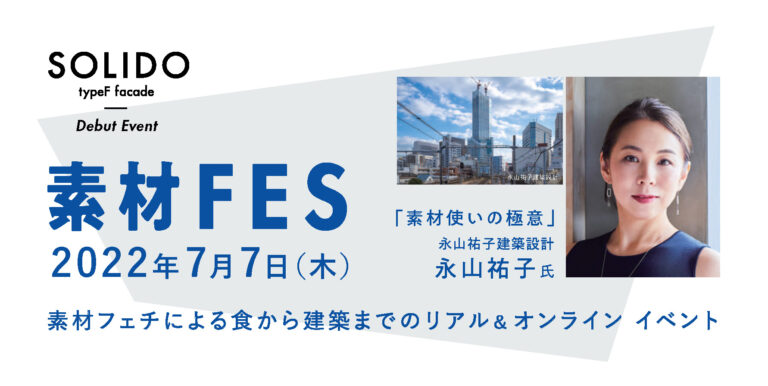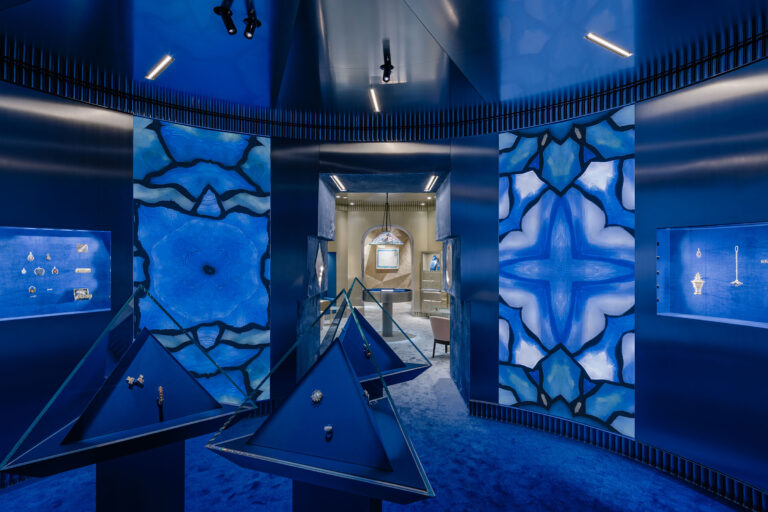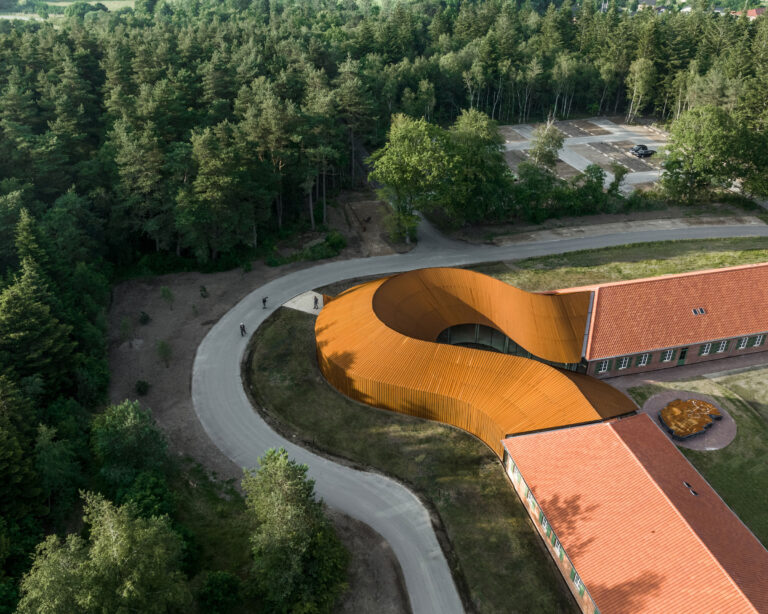
SHARE BIGによる、デンマーク・オクスボルの博物館「FLUGT」。第二次世界大戦時の病院を改修した“難民”に関する施設。二棟の既存建物を建築的にも歴史的にも繋げる、カーブを描くヴォリュームを増築。展示資料に加え体験でも難民と地域への理解を促す




BIGが設計した、デンマーク・オクスボルの博物館「FLUGT – REFUGEE MUSEUM OF DENMARK」です。
第二次世界大戦時の病院を改修した“難民”に関する施設です。建築家は、二棟の既存建物を建築的にも歴史的にも繋げる、カーブを描くヴォリュームを増築しました。そして、展示資料に加え体験でも難民と地域への理解を促す事を意図しました。施設の公式サイトはこちら。
こちらは建築家によるテキストの翻訳
第二次世界大戦中のデンマーク最大の難民キャンプ跡地に位置する「FLUGT」は、世界中の難民に声と顔を与え、避難民が共有する普遍的な課題、感情、精神、物語をとらえています。FLUGTは、Vardemuseerne(※クライアント)のためのBIGの2番目の博物館であり、この地域に関する歴史的知識の考古学、普及、収集に特化した地域機関です。BIGは、収容所に残っている数少ない建造物のひとつである病院の建物を、1,600m2の博物館に改修・拡張しました。
収容所の最盛期には、当時のデンマークで5番目に大きな都市となりました。現在、オクスボルの収容所はほとんど残っていませんが、新しい国の入り口に到着したというストーリーは、これまでと同じように重要です。FLUGTに生まれ変わった旧病院は、2つの細長い建物で構成されています。BIGはこの2つの建物を建築的にも歴史的にもつなげ、柔らかなカーブを描くヴォリュームを加えることで、美術館に500m2の追加スペースをもたらし、遠くからでも見える歓迎する構造体を作り上げました。
このカーブは、通りに向かって緩やかにひかれ、美術館の来館者に魅力的な到着の瞬間を演出します。コールテン鋼で覆われた構造体は、旧病院の赤レンガに調和しています。外から見ると、抽象的なヴォリュームは、一見閉じたエントランスホールに訪問者を迎えます。中に入ると、床から天井までの曲面ガラスの壁から、緑に覆われた中庭と、かつて難民キャンプがあった森が見えます。中庭から光が差し込むエントランスホールは、ロビーや企画展示スペースとして機能し、ゲストが館内を移動する前に体験することができます。
北棟の展示エリアは、病院内の動線に合わせて構成されたギャラリースペースです。病室の壁のほとんどは取り壊されましたが、内壁の一部はそのまま残され、3つの断面によって安定し、より広い展示スペースを作り出しています。南館は、フレキシブルな会議室、小展示スペース、カフェ、裏方機能などを備え、北館と同じ性格と素材感を持っています。白い壁と交線は、天井の角度に合わせて白く塗られた木板で覆われ、美術館の床全体には黄色のレンガが敷かれ、過去と現在の構造をつなげています。
病院の建物を歴史的価値から保存・再利用するだけでなく、既存建物の寿命を延ばすことは、廃棄物の削減、資源の節約、材料の製造や輸送に関連する二酸化炭素排出量の削減というBIGの使命を支えるものです。
BIG Landscapeが設計した中庭は、館内だけでなく、屋外でも穏やかな感覚を味わうことができます。中庭の中心にある小さなミラープールは、その上に広がる空を映し出します。水盤の周りには、この地域で知られるヒースの植栽が施され、地域のアイデンティティを強調しています。来館者は、デンマークの歴史における重要な場所の一部を体験し、難民の経験について新たな視点を得て、博物館を後にすることができるのです。
以下の写真はクリックで拡大します



























以下、建築家によるテキストです。
Located at the site of Denmark’s largest Refugee camp from World War II, FLUGT, gives a voice and a face to refugees worldwide and captures the universal challenges, emotions, spirit and stories shared by displaced humans. FLUGT is BIG’s second museum for Vardemuseerne: a local institution dedicated to archaeology, dissemination, and collection of historical knowledge about the region. BIG has adapted and extended one of the camp’s few remaining structures – a hospital building – into a 1,600 m2 museum.
At its peak, the camp became the fifth-largest city of Denmark at the time. Today, little of the camp in Oksbøl remains, but the story of arriving at the doorstep of a new country is as relevant as ever. The former hospital, which is transformed into FLUGT, is comprised of two elongated buildings. BIG has connected the two buildings architecturally and historically by adding a soft curve-shaped volume which brings 500 m2 of additional space to the museum and creates a welcoming structure, visible from afar.
The curve is gently pulled towards the street to create an inviting arrival moment for the museum visitors. Clad in Corten steel, the structure feels at home along the red bricks of the former hospital buildings. From outside, the abstract volume welcomes visitors into what appears to be a closed entry hall. Upon entering, a floor-to-ceiling curved glass wall reveals a view of a sheltered green courtyard and the forest, where the refugee camp used to be. The courtyard lets light flow into the entry hall that functions as a lobby or a temporary exhibition space for guests to experience before continuing their journey into one of the museum wings.
The exhibition area in the north wing contains gallery spaces organized according to the original flow/circulation in the hospital. While most of the hospital room walls were torn down, some of the inside walls are kept intact and stabilized by three cross sections, creating larger exhibition spaces. The south wing features a flexible conference room, smaller exhibition spaces, cafe, and back of house functions with the same character and materiality as in the north wing: white walls and intersections covered in white painted wood boards oriented according to the angle ceiling line, as well as yellow bricks across the entire museum floor, connecting past and present structures.
In addition to preserving and reusing the hospital buildings for historical value, extending the lifespan of the existing structures supports BIG’s mission of reducing waste, conserving resources, and creating a smaller carbon footprint as it relates to materials manufacturing and transport.
The courtyard designed by BIG Landscape creates a peaceful sensory experience inside the museum as well as outside. A small mirror pool in the heart of the courtyard reflects the sky above it. Around the basin, heath planting known from the region emphasizes the identity of the area. Visitors leave the museum having experienced a part of an important place in Danish history, with a new perspective on the refugee experience.
■建築概要
Name: FLUGT – REFUGEE MUSEUM OF DENMARK
Code: FLUGT
Location Text: Oksbol, Denmark
Location: (55.6280388,8.2801861)
Program: Culture
Status: Completed
Size in m2: 1600
Project type: Commission
Client: Vardemuseerne
Collaborators: Johansson & Kalstrup, Tinker Imagineers, BIG Landscape
Date: 25/06/2022
───
PROJECT TEAM
Partners-in-Charge: Bjarke Ingels, Ole Elkjær-Larsen, Finn Nørkjær
Project Leader: Frederik Lyng
Project Architect: Frederik Skou Jensen
BIG Team: Ákos Márk Horváth, Anders Holden Deleuran, Andy Coward, Anne Søby Nielsen, Cheng-Huang Lin, Danyu Zeng, David Zahle, Eddie Chiu Fai Can, Gabrielé Ubareviciute, Hanne Halvorsen, Høgni Laksafoss, Laura Wätte, Katrine Juul, Kim Lauer, Lone Fenger Albrechtsen, Lukas Molter, Mads Primdahl Rokkjær, Marius Tromholt-Richter, Michael James Kepke, Muhammad Mansoor-Awais, Nanna Gyldholm Møller, Nikolaos Romanos Tsokas, Oliver Siekierka, Peter Mortensen, Richard Garth Howis, Sascha Leth Rasmussen, Sofiia Rokmaniko, Tore Banke, Thor Larsen-Lechuga, Tomas Karl Ramstrand, Toni Mateu, Tristan Robert Harvey
BIG Landscape: Anne Katrine Sandstrøm, Barbora Hrmova, Giulia Frittoli, Jonathan Udemezue, Kristian Mousten, Ulla Hornsyld

